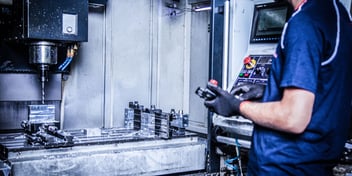The advantages & disadvantages of a CNC plasma cutting machine
Are you considering purchasing a CNC cutting machine? If so, it pays to know all the pros and cons before making your decision.
In this article, we delve into the benefits and drawbacks of CNC plasma machines.
How does a CNC plasma machine work?

A CNC plasma cutter is a thermal cutting tool used to cut various metals, producing clean and accurate cuts. Common users of CNC machines include fabrication shops, manufacturing, automotive repair and restoration, and training centres. In these environments, CNC plasma machines are used to cut components from flat metal sheets or plates.
Depending on the machine and equipment, a CNC plasma machine can cut a wide range of materials. Generally, they are used in industrial manufacturing to cut through electrically conductive metals, such as steel, aluminium, stainless, brass, and copper.
Advantages of CNC plasma cutters
From efficiency to versatility and precision, CNC plasma cutting machines provide a number of advantages.
Efficiency
CNC machines are incredibly quick and easy to use, meaning they will significantly increase your team’s productivity. Compared to other cutting machines, such as lasers and water jets, CNC plasma machines have a lower operating cost and are generally less complex.
Safety and automation
The software used to control your CNC plasma cutter makes it much easier to operate. It’s also fully automated, making it more user-friendly and ideal for speeding up production. Whilst safety precautions should always be used for plasma, the arc is not as dangerous as a laser beam which can be extremely harmful. For this reason, a laser needs to be enclosed to protect the operator, whereas a CNC plasma cutter is open which makes it easier to load sheets and work on.
Easier to repair
Compared to Laser and Waterjet machines, CNC plasma cutters are much easier and more affordable to repair. In the event of a breakdown, such as torch damage or malfunction, your CNC machine will be back up and running for a fraction of the cost.
Versatility
Generally, they are used in industrial manufacturing to cut through electrically conductive metals, such as steel, aluminium, brass, or copper.
Precision
When cutting hundreds of items in your workshop, a quality CNC plasma machine can dramatically improve your cut performance. With its software and automation, it’s easy to cut a wide range of metals in various shapes and thicknesses.
Cost-effective
CNC plasma cutting costs are relatively affordable, especially when compared to Laser and Waterjet alternatives. Industrial-quality systems are available for a reasonable price and our CNC Plasma Table packages start from $31,900, or $30 per day finance cost. In comparison, Waterjet and Laser equipment typically start at around $100,000+ for upfront costs, not to mention the running costs.
The gap between set-up cost for Laser compared to CNC plasma widens, particularly when cutting steel thicker than 10mm. The initial investment cost for a CNC plasma cutter is a lot lower for thicker materials, making it a more accessible option for small to medium-sized businesses.
You can get accurate pricing using our online price configurator here.
Finance available
When investing in a new industrial cutting machine, the upfront cost can be daunting. Fortunately, many CNC plasma manufacturers partner with a finance provider to help you get the CNC machine you need. This way, you can increase your production speed and make more money sooner.
At Surefire CNC, our packages start from a finance cost of around $30 per day, based on a 5-year term.
Disadvantages of CNC plasma cutters
While the advantages far outweigh the disadvantages of CNC plasma cutters, it’s important to be aware of the following drawbacks.
Potential for poor quality machines
If you opt for a cheap CNC machine of poor quality, you risk issues with the equipment and software. Some manufacturers take shortcuts when developing their software but this results in programs that are inefficient and often difficult to use. To avoid this, we recommend opting for our Surefire CNC XT Series Plasma Tables that come standard with our easy-to-use SURECONTROL software.
There’s also a lot more to a CNC plasma machine than just the table and the plasma cutter. Rather than tempt you with a cheap and incomplete package, we go the extra mile to prepare a complete, industrial-quality package that includes everything you need to get the most from your machine.
Cut quality
Compared to some cutting machines, the cut precision on a CNC plasma cutter may be slightly lower. Waterjet and Laser machines both offer a higher level of cut quality and precision, however, they are more expensive to purchase and operate.
Plasma will always have some degree of edge bevel angle and some dross. When cutting materials less than 3mm thick, heat distortion may also be a concern. However, these imperfections can be minimised by using reputable software with good Torch Height Control (THC) and the correct operator techniques.
In saying that, plasma cutting offers more than enough accuracy for most industrial applications, while also being simple and cost-effective to operate.
Best machines for metal fabrication
No single CNC system will offer the “best of everything”. However, for first-time investors, CNC plasma is easily the most cost-effective and practical choice when it comes to metal fabrication work. To decide which machine is best for your application, read our recent article comparing Plasma, Laser, Waterjet, and Oxy or download our Buyer’s Guide below.



